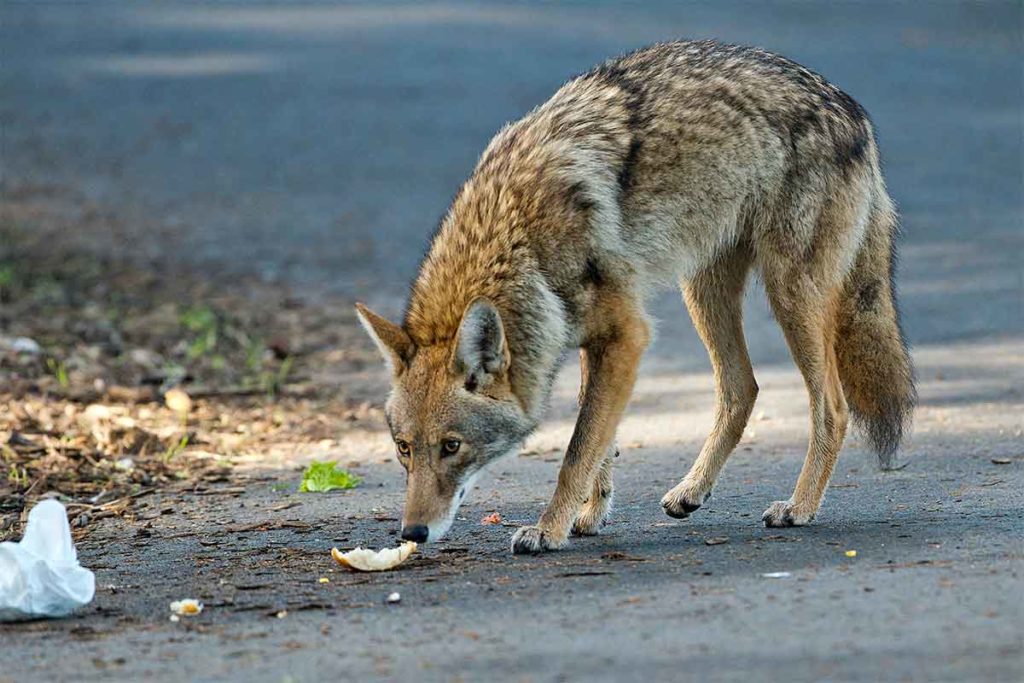Has your pet come face to face with a coyote recently? Even if you were right there, it probably struck fear not only into your pet’s heart but into yours as well.
As urbanization sprawls into canyons, woodlands, and other areas that until recently have been home to animals only, confrontations between wildlife, humans, dogs, and cats become more numerous, not to mention more dangerous for all involved. Wildlife can become habituated to human presence, making them less wary, and they can become addicted to the easy pickings of pet food and water left outdoors.
Sometimes these confrontations may be potentially dangerous to humans, but more often they are potentially dangerous to our companion animals–unless we make a few easy adjustments. That’s especially important in the case of coyotes, arguably the most successful of all non-bird species.
A few years ago, in downtown Chicago, a coyote walked into a convenience store and helped himself to a few treats. Also in the Windy City, on a Friday night, in the busy bar-area near Wrigley Field, a pair of coyotes nonchalantly walked alongside patrons on the street before dashing off. In New York City and Los Angeles, coyotes have learned to make a living off other wildlife, even city rats, as well as by raiding trash cans. These scenarios repeat around the country in urban and rural America.
Wily indeed, they have learned to thrive in urban areas and their ubiquity has made them America’s most hated animal, according to a recent National Geographic survey. That’s because every year there are increasing reports of coyotes killing dogs and cats, and people becoming enraged. After all, dogs and cats are members of our families. There are even drives to kill coyotes. Some people put out poison and others shoot them if they can.
I suggest such action is unnecessary.
For starters, if villagers in Africa can live with elephants destroying a year of crops in one night or even trampling on a home, and in Asia a deadly snake might appear in the middle of the night, I think we can deal with coyotes, who aren’t a threat to adult humans.
Coyotes generally aren’t going to try to take down a very large dog, but mid-size dogs and certainly small dogs are at risk. And cats don’t have a chance unless they scamper up a tree to get away.
However, coyotes rarely have keys to homes. Indoors, cats are safe.
I understand that cats who have been outdoors their entire lives may not be so eager about moving inside. But when we create a more stimulating environment indoors, many cats adjust. And sometimes older cats appear grateful for the opportunity to “retire.”
The secret to protecting dogs is pretty simple: being on a leash with an adult human on the other end. Coyotes aren’t typically brazen enough to threaten human adults. If one doesn’t scamper off as you approach with a pup on leash, holler, “Go away!” If that fails, employ a technique called hazing, making a sudden noise such as blowing a loud whistle or bicycle horn.
At home, I understand that it’s easier to just let dogs out in the backyard without supervision. But where there are coyotes, this habit comes with inherent risks. But with some effort you can get around those.
It’s possible to protect yards against coyotes. Coyote-proof fences are at least eight feet tall and made of a material that coyotes cannot climb or at least six feet tall with a device on top such as a coyote roller, which rolls off any coyotes who try to scramble over the fence. Adding piping or chicken wire to the top of your fence can also prevent coyotes from getting the foothold they need to make it over. To prevent coyotes from digging under a fence, make sure the fence extends at least 12 inches underground.
Coyotes are less motivated to enter our yards if people in the neighborhood (not only you) don’t leave pet food or water outdoors, when a potential dinner from our trash cans becomes unavailable because we use tight-fitting coyote-proof lids, and when we don’t leave pets in yards unsupervised.
Of course, the coyotes are only trying to survive. Let’s try to live cooperatively with them, while still protecting our pets and preventing the fear, anxiety, and stress of an unwelcome wildlife interaction.
This article was reviewed/edited by board-certified veterinary behaviorist Dr. Kenneth Martin and/or veterinary technician specialist in behavior Debbie Martin, LVT.








